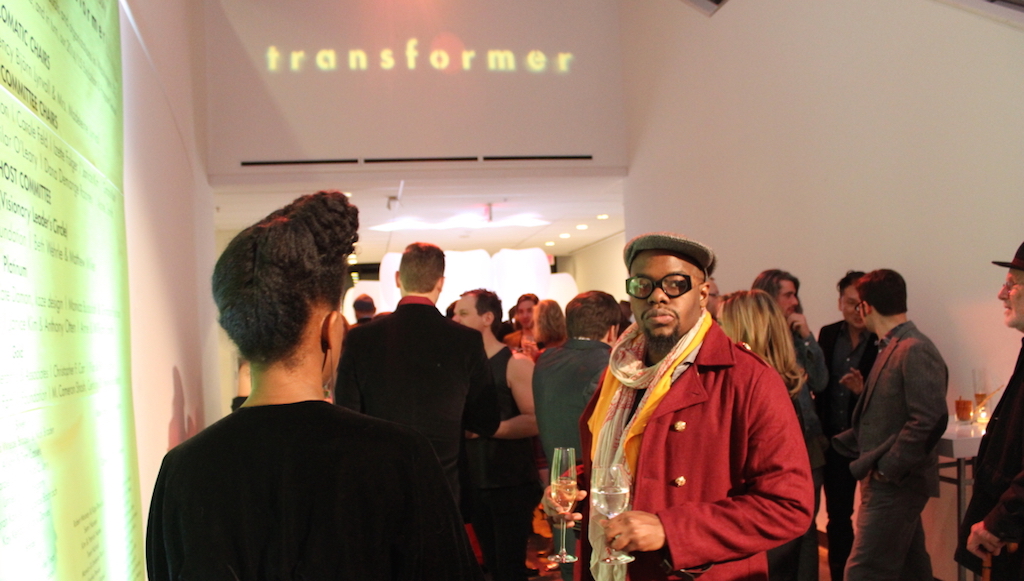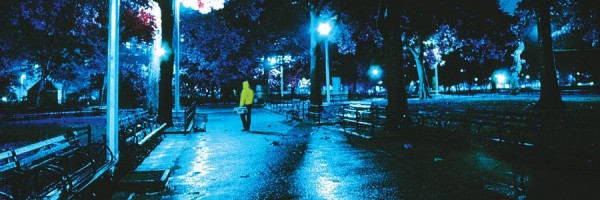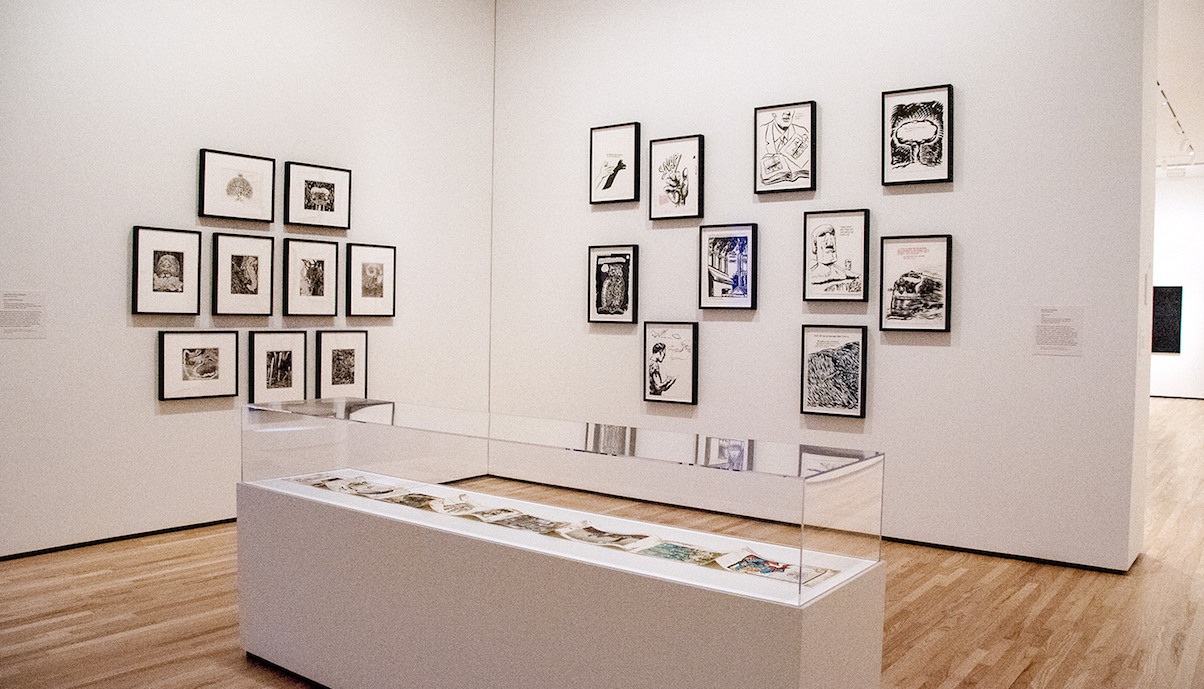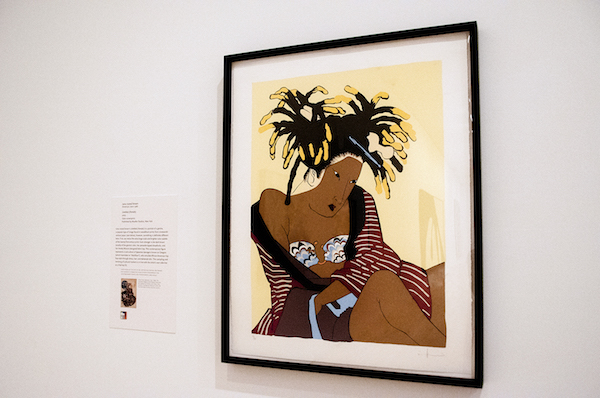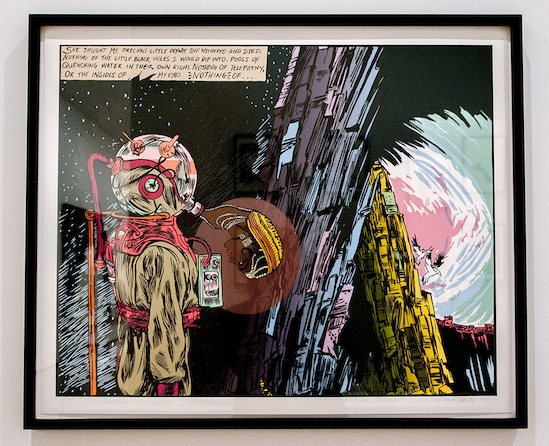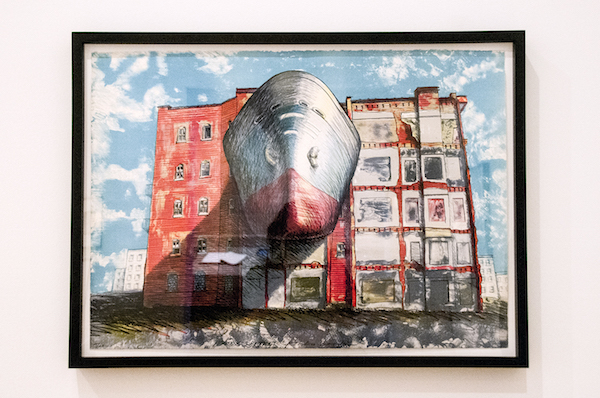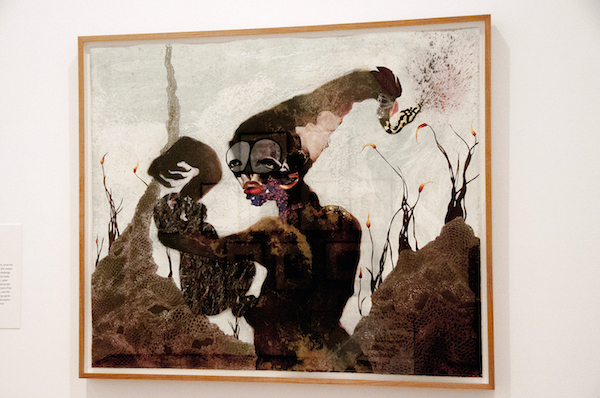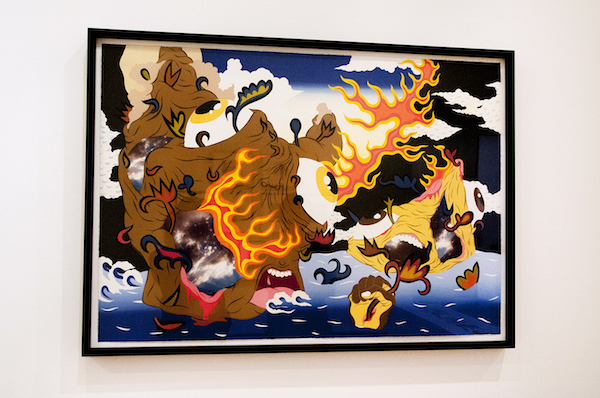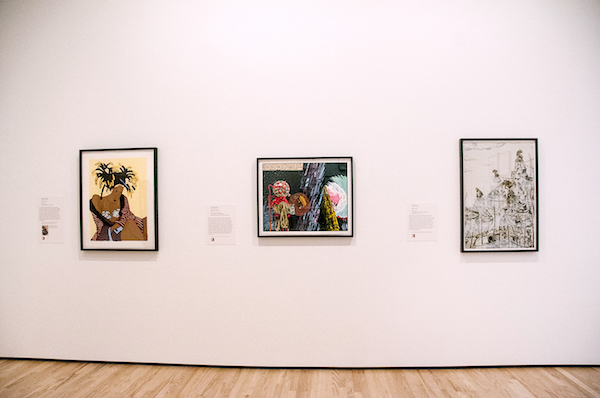Alternate Realities at the BMA reviewed by Susan Ren
We all feel strongly about particular societal concerns, and quite naturally, we want to inform others. Unfortunately, being too forward most often causes discomfort and dismissal of the problem. People prefer comedy to a heavy discussion, but how can serious news avoid trivialization?
In celebration of the Baltimore Museum of Art’s 100th anniversary, Associate Curator Ann Shafer combines nine US-based narrative artists in a comical yet informative show that collages pop culture with myth and fairytale to examine the human condition in relation to a jumble of societal issues, paradoxically creating wholly believable new worlds.
Appropriating the style of Japanese woodblock printing to comment on cultural appropriation, in Untitled (Female), Iona Rozeal Brown presents a portrait of a geisha fashioned with darkened skin, bikini, and dreadlocks. This unusual depiction is simple but alluring, and illustrates a Japanese sub-culture of teens that have appropriated an African American hip hop style as their own. They call themselves “Ganguro” or literally, “blackface” and see this title as one of pride, but without comprehending the historical implications.
In another screen print combined with woodcut, Chitra Ganesh uses a colorful, retro comic book style that contradicts locations and emotions, representing a collection of responses to catastrophe. Left intentionally ambiguous, Ganesh’s Away from the Watcher presents both an astronaut and a scuba diver, while the scene itself appears to take place in outer space and/or the ocean, and the pulp-commic comment in the caption does not appear directly relate to the imagery. These inconsistencies create a new unknown world that, by contrast, helps bring perspective to actual reality.
The new world created by Amy Cutler in Widow’s Peak is more straightforward. In a color lithograph, she portrays women dressed in old world clothing, individually climbing up the peaks of tall mountains. What is most curious about the image is that the women are all carrying goats on their backs – which may be an unusual way to display their strength or could represent the burdens each must carry. In Cutler’s alternate reality, she addresses the oppression of women in history by bringing them into a place where they have a chance to physically and metaphorically show their power.
Political cartoons meet personal sketchbook doodles in Raymond Pettibond’s Plots on Loan I. In this series of illustrations, the captions are borrowed from 19th Century writers and used alongside universal, appropriated imagery to display his feelings toward specific cultural difficulties. With the intention of letting viewers interpret the relation of his images with the text, Pettibond is vague in his implications, yet bold and direct visually.
Enrique Chagoya’s El Regreso del Caníbal Macrobiótico, an accordion-bound volume of woodcut and lithographic images functions like an “I Spy” game of cultural appropriation. Every page is detailed in iconography borrowed from American comic books, Mexican folklore, art history, and religion. The work itself also yields the form of ancient Mayan and Aztec books, read from right to left with each page labeled accordingly. Chagoya tells a complicated story about cross-cultural identity and relationships, pondering how the world would be different if Mesoamerican culture dominated, rather than European. There is no indication of whether it would have been better, but the idea raises questions about current cultural assumptions and international relations.
Vivid storytelling is also central to Trenton Doyle Hancock’s work. In the series Bye and Bye (9 Sad Etchings), a lion, elephant, squirrel, shark, ostrich, and alligator have gathered to deliver a eulogy for their friend “Mound Number One” who has died. What each character is saying relates to Hancock’s previously fabricated story of enemies – the “peace-loving Mound” versus the “evil Vegans.” Though some background must be understood to fully grasp his narrative, each individual piece delivers its own intriguing perspective on the interaction between morality and corruption.
Though surreal, Toshio Sasaki’s Bronx Project feels more literal than the other artwork in the show. Previously a Japanese architect, his work is reminiscent of drafted sketches for industrial design. In his illustration, a ship protrudes out of a building as if it had tried to sail right through. Due to his appropriately chosen title, it is made very clear that his work regards the continuous struggle to make space in a crowded city.
Wangechi Mutu’s desert alien figure in Second Born is the most deliberately bizarre character in the show. Layers of textures made with collagraph, relief, digital printing, collaged magazine cut outs, woven materials, and the most intriguing, 24 karat gold, set the scene in what appears to either be the grasslands or another planet. Fragments of a stereotypical “jungle” feel emerge in the work, but the general unfamiliarity of the piece as a whole confronts and questions modern uses of the female African body in media.
Another alien-like creature is explored in William Villalongo’s screen print, Through the Fire to the Limit where a creature with no sensible order to its eyes or mouths burns bright flames while emerging from the ocean. Created in 2006, a graffiti aesthetic eases the point of discussion in the piece – Hurricane Katrina. While remaining humorous to view, the work is also surprisingly realistic in its depiction of ruthless destruction.
Although each artist in Alternate Realities at the BMA approaches serious topics such as war, race, colonialism, violence, and natural disaster, it is obvious that each intuitively understands that a viewer will turn away when faced with an unpleasant reality. In the case of these nine artists who all employ a variety of printing techniques, when the use of surreal imagery and humor are implemented to present difficult issues, less tension occurs which leads to more learning. Although each employs a different ingenious tactic to visually entice a viewer, all have chosen to expose them to challenging ethical societal issues. Interestingly enough, time spent in another world leads to gaining a better understanding of your own.
On Paper: Alternate Realities will be on view at the Baltimore Museum through April 12, 2015.
Author Susan Ren grew up in Columbia, MD (where she often felt misplaced) and graduated from the University of Maryland, Baltimore County (where she felt only a little less misplaced). She is now a Baltimore-based visual artist, photographer, writer, cat lover, and DIY-enthusiast in a city that feels right.
